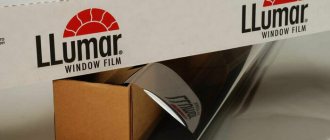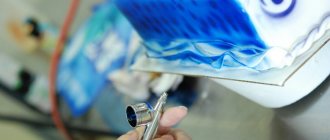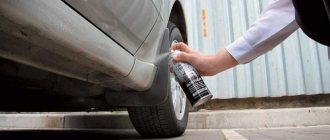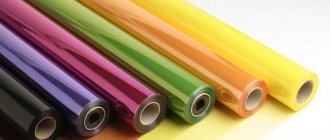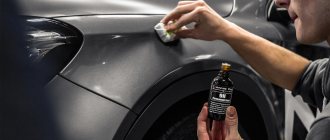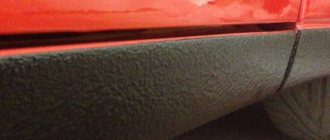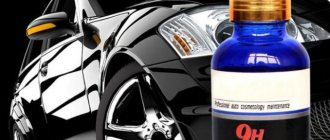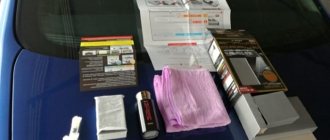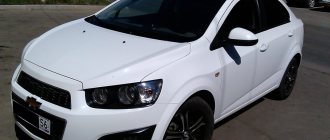Repost and the information will always be at hand ✅
Liquid glass for a car is a special coating (polish) that provides reliable protection for the car body. Proper processing before application is important. If all rules are followed, liquid glass will retain its appearance for 6-12 months.
What does the body look like after coating with liquid glass?
The price of car polishing will depend on the brand of the product manufacturer. Saving is not recommended; cheap compounds lack important components that provide increased adhesion strength.
Previously, wax-based compounds were used to protect car bodies. But the development of technology has opened up the possibility of using silica-based products - this is simple sand.
The article contains everything about liquid glass for cars: what it is, types, pros and cons, how much it costs, how to apply, how long it lasts, manufacturers and prices, reviews and photos.
What it is
What is liquid glass? This is a highly effective car polish that surpasses all other analogues in its properties.
What does it consist of? Liquid glass contains silicon dioxide (quartz, silica or quartz glass). In the production of liquid glass, the method of melting soda and quartz sand is used. The result is a safe and high-quality polishing material. Experts say that this remedy is very worthy of attention.
What does silicon dioxide look like?
Liquid glass was invented in Japan more than 10 years ago. Due to its long-lasting effect, this invention has become very popular all over the world. Liquid glass also has another name - ceramic varnish.
Previously, products for restorative car polishing were produced by well-known brands from Japan. Now the range has increased, there are many options on the market from different manufacturers.
A new car purchased at a showroom has a “solid” rich color and an ideal appearance. Even a careful driver’s car stays in this condition for no more than 3 years. As a car ages, the paint fades, the color changes to dull and unattractive, and the surface becomes scratched, chipped, and uneven. Therefore, the procedure of polishing and coating the body with liquid glass comes to the rescue.
Why do you need to cover your car with liquid glass? When using polish, the appearance of the car changes for the better. A noticeable shine appears on the surfaces, and the body itself acquires reliable protection. The car looks like new again. A mirror effect will appear on the body - everything will be reflected in it. It looks very impressive!
Beautiful gloss on the hood after treatment with liquid glass
The service life of surface paint coating is always different. Trusted manufacturers of polishes provide a guarantee on their products. It can last from 1 year to 3 years.
The composition of liquid glass for cars includes the following components:
- Addition of aluminum and titanium oxides to a mixture of silicon dioxide (SiO2);
- Liquid with silicone;
- Surfactants – surfactants;
- Chemical additives that are used to make polymer film.
Aluminum oxide protects the body from microcracks, dust, dirt and exposure to sunlight. Liquid glass, when applied to paintwork (paint coating), forms a hard film on it, thanks to which water and dirt drain from the body. Therefore, modern liquid glass is equated to nanoceramics. Silicon dioxide is a durable transparent substance that envelops the paintwork, filling all irregularities and microcracks, without harming the paintwork.
Surfactants are added to many detergents. These active substances effectively repel dirt from the body.
The silicone mixture inhibits oxidative processes and improves the adhesion of liquid glass to the body . Other components are used in different proportions to improve the composition of liquid glass.
Liquid glass can be used on plastic and chrome, including headlights. But such compounds are not suitable for repairing chips on glass.
The hardness of liquid glass is actually a myth. Glass in this mixture is only 10-25%, which is not enough for complete protection from damage.
In general, glass has a very high density and survivability. Some types of glass are harder than steel. For example, the front windows of the Mi-28 helicopter can cope with a direct hit from a 20-mm projectile.
Liquid glass for a car - what is it and what is it for?
The body is the most visible and expensive part of the car, so means of caring for it and protecting it from adverse influences are always in demand. For a long time, protective polishing with wax-based materials was used for the body, but the development of technology has opened up the possibility of using compositions based on silicon compounds.
Actually, the basis of what is usually called glass or ceramics is ordinary sand. More precisely, not the sand itself, of course, but silicates - salt compounds of silicon.
Alkaline solutions of sodium or potassium silicates have long been well known and are used in construction (waterproofing) and in everyday life (office glue). By the way, sometimes liquid glass is also produced like regular glass: by sintering sand and, for example, ordinary soda at high temperature.
The main ingredients of the coating are the following:
- Additions of titanium and aluminum oxides using a certain technology to a material containing silicon dioxide (sand),
- Silicone based liquid,
- Surfactants (surfactants),
- Chemical compositions used in the production of polymer films.
Titanium oxide creates a thin film for thermal protection of the material at the level of nanoparticles, so modern liquid glass is rightfully classified as nanoceramics. It is this substance that gives the coating a glossy shine.
Surfactants are used as an ingredient found in detergents. Surfactants are needed to “repel” dirt particles remaining on the prepared surface of the body, which can interfere with the coating formation process.
The silicone base serves to prevent oxidative processes and improve adhesion (“adhesion”) of the coating to the body surface.
The remaining components can be used in different proportions, but the “sand” base of liquid glass, which improves the strength characteristics of the coating, remains unchanged.
What does liquid glass do for a car’s paintwork, besides adding shine?
First of all, it is a harder surface than conventional car varnishes.
Hardness, by the way, is determined in the same way as for graphite pencils and has the index “H”.
However, it should be remembered that the hardness of the coating will largely depend on the preparation of the surface to be protected:
- for new cars coated with “hard” production varnishes, the final (after application) hardness of the coating will be maximum;
- for repainted surfaces, the hardness of the applied coating will be lower than for coatings of new cars due to the fact that repair varnishes are usually “soft”;
- Ensuring uniform hardness for cars with significant mileage is generally problematic, since in addition to painted (and possibly at different times) body parts, various (even abrasive) preliminary preparation of these parts may be required.
Liquid glass creates a coating that is more capable than car varnish of preventing the appearance of chips, scratches, and small dents, not only due to increased hardness, but also due to a certain plasticity. And, of course, such a coating is additional protection from an aggressive environment.
Often in advertising materials dedicated to liquid glass you can find a statement that the use of the coating improves the saturation of the body color and makes it deeper and brighter. Of course, this kind of statement is nothing more than a myth.
Even if the transparency of the coating were ideal (100% light transmission!, which in fact does not happen), the brightness and saturation of the original color could, at best, be preserved. Another thing is that the coating components significantly reduce the harmful effects of ultraviolet radiation on the paint, preserving the “native” color for as long as possible.
After properly applying the coating to the car and after long trips, it is enough to rinse the car with clean water without using detergents - the shiny surface of the body is instantly restored.
Among the disadvantages of coating with liquid glass, the only thing worth noting is the high final (materials plus labor) cost of the process. At the same time, the labor intensity of the process of preliminary surface preparation, especially for used cars, is indeed quite high.
How long does liquid glass coating on a car last?
The world's leading manufacturers declare the durability of the coating while maintaining its basic properties for two to three years. According to reviews from Russian motorists, the average durability of such coating on Russian roads is 1 year.
Types of liquid glass
Manufacturers of automotive liquid glass use different silicates as a base:
- Potassium glass . Potassium-based products have a loose, porous structure. Distinctive advantages: resistance to aggressive environments, increased moisture resistance, fits well on a glossy surface.
- Sodium liquid glass . The material is characterized by increased resistance to mechanical damage, dirt, has fire protection, and takes shock loads well.
- Lithium glass . Considered as a finishing coating for cars. Fixes the protective layer and provides thermoregulation. The durability of such compositions is reduced, therefore it is recommended to apply them exclusively before winter. This is the most unpopular type of liquid glass.
According to the method of application, liquid glass can be:
- Self-hardening;
- Requiring the application of a fixative.
No. 8. Foundation waterproofing with liquid glass
To waterproof the foundation and plinth, coating technology is usually used. Liquid glass goes well with rolled waterproofing materials. Silicates are incompatible with bitumen waterproofing.
To reliably protect the foundation from moisture, the surface must first be cleaned and degreased, then sanded, and then the liquid glass itself must be applied with a wide brush. When the first layer has dried, apply the second, and after final hardening, you can begin to roll waterproofing.
We recommend: How to choose a compressor for a sandblaster
To protect joints and seams on the foundation, you can use penetrating technology:
- seams and joints are embroidered, U-shaped grooves are made in places of cracks, then all recesses are cleaned of dust;
- the mixture is prepared in small portions;
- A solution with a concentration of about 5% is prepared from water and liquid glass, then it is added to the cement. The result should be a thick plastic mass. It is better to stir once; when stirring again, crystallization may begin, which will negatively affect the adhesive properties;
- The prepared solution is applied with a spatula to the embroidered joints and seams. It dries out very quickly.
Advantages and disadvantages
Before you buy liquid glass, you should study its advantages and disadvantages.
Advantages of high-quality liquid glass:
- the hard layer protects the body from destruction when chemical reagents come into contact with it. This will greatly extend the life of the car's paintwork;
- it is possible to completely cover the entire surface of the car (clarification required before the procedure);
Liquid glass can even cover headlights and other plastic parts. - rich, long-lasting color, mirror effect, the car shines as if it had been washed, microcracks are not so clearly visible;
- low cost of liquid glass. Painting body parts will cost much more;
- high-quality liquid glass applied in several layers will help reduce the likelihood of chipping from stones. But no one has yet officially conducted tests for chips;
- durability - with careful operation of vehicles, the applied composition lasts for a year and longer than wax or epoxy Teflon polishes;
- water-repellent effect - dirt and moisture are quickly removed from the surface of the car; during rain, water will drain off the body itself. These are the so-called “anti-rain” and “anti-ice” effects;
Liquid glass has a water-repellent effect - easy to apply. The composition is simply and quickly applied to the car body. The main thing is to follow all application rules so as not to spoil the appearance of the car;
- if after six months the liquid glass becomes dull, it can be slightly renewed;
- The effects of ultraviolet radiation and heat are blocked. Even if the car is exposed to sunlight for a long time, the product will not lose its original properties;
- transparency - the liquid film is colorless, so it gives the car a radiant shine;
- savings on a car wash will be several times higher than the cost of processing with liquid glass;
- in case of replacing a body part, it is not necessary to completely remove the liquid glass;
- antistatic effect - dust will not be attracted to the body;
- Helps protect against scratches and minor damage. Liquid glass will definitely protect against damage from static contamination during washing or from road sandblasting;
- It protects well from those who like to risk spray paint on car bodies;
- will improve the pre-sale preparation of the car.
Flaws:
- price – the composition itself and the work involved in applying it are expensive, but you can get the same quality for less money by doing the work yourself;
- liquid glass is “capricious”; before using it, the machine must be properly prepared and processed;
- does not cope well with strong alkaline compounds (relevant for cheap products);
- If the body is washed with detergents, the liquid glass will quickly be “washed off”. Therefore, you need to wash the car with plain water and wipe with a soft sponge;
- An accidental impact may cause the coating to crack;
- The coating does not cover scratches. Only after polishing the body do scratches become less visible. No liquid glass can hide or fill chips and scratches on the body;
- Liquid glass does not have its own hardness. This coating actually makes the paintwork itself harder. For example, if you cover the body of a car with soft paintwork with 5 layers of liquid glass, it will be less protected compared to a fresh car with factory paintwork;
- old cars need to be specially prepared before the procedure;
Before the procedure, cars need to be polished for a long time and with high quality. - in severe frost, liquid glass quickly loses its properties;
- There are certain requirements for further care; gentle washing is recommended.
Another good article: Athermal tinting: what is it, pros and cons, types, price of film, GOST and traffic police, reviews and photos
It is worth considering that the consumer will receive all the advantages and a minimum of disadvantages only if they use original liquid glass. How the fake will work is unknown.
Now it’s clear how liquid glass differs from ceramics and car varnishes. In many respects it is superior to its analogue. In addition, if you have a certain skill, you can do the work yourself, without the help of a specialist.
The hardness of liquid glass is harder than that of conventional car paint coatings. Hardness has the index “H”, which corresponds to the characteristics of graphite pencils. That is, it is harder than paintwork.
Despite marketing claims that liquid glass will enhance color saturation and depth, in reality it is just a gimmick. If the light transmission of liquid glass were 100% (which is impossible to achieve in practice), then at best the product would only help maintain the brightness and depth of color, but nothing more. The coating protects against the harmful effects of UV radiation, so the original color of the car is preserved for a long time.
What is liquid glass?
There are two types of liquid glass: sodium glass and ceramic.
The features of soda glass are fire resistance, adhesiveness and the ability to interact with minerals, which is successfully used in foundation reinforcement and the production of fire-resistant and antimicrobial chemicals.
Ceramic glass is distinguished by its high resistance to atmosphere and acids, which is why it is also used in the creation of artistic paints.
Liquid glass as a material attracts not only its strength and moisture resistance, but also its ability to withstand strong chemical and mechanical influences.
The degree of protection of the surface from moisture and other things directly depends on how deeply the liquid glass penetrates into it. But in any case, first the surface is leveled and gets rid of fat.
To apply glass to the material, use either a standard brush or a spray gun.
The composition is applied to plaster and concrete so that it penetrates 2 mm inside. For better protection against moisture, the glass needs to penetrate deeper, namely 20 mm.
In order for the material to reach such a depth, the composition is applied several times.
It doesn’t matter how deep the glass goes, the main thing is that you should always pay attention to the joints and seams - they must be sealed especially carefully
For places with particular humidity, such as a swimming pool or basement, a solution of glass and concrete with a ratio of 1:10 is used.
As an insulating material, liquid glass is an excellent option due to its antiseptic properties.
Plus, it seals well, which is why it is used in especially difficult places: basements, attics and the like.
These places are especially susceptible to fungi, high humidity and mold, and fires often occur in them, from which liquid glass will not completely protect, but will smooth out the consequences.
Glass is also used with porous materials, such as plaster or concrete - it restores and reinforces them, simultaneously cleaning them from microbes.
The antiseptic properties of liquid glass also explain its use in treating metals against rust.
Video:
Waterproofing is required not only for the walls of a pool or well, but also for the foundation. Foundation slabs are also processed in several ways.
The first method is the most obvious to a layman. The surface is simply coated with several layers of glass, after which another type of insulation is laid.
It is recommended to apply glass in at least two layers so that it penetrates as deeply as possible into the material.
In addition to coating the foundation, there are other ways to strengthen it with liquid glass.
For example, mix glass into mortar. You can add it to cement if the leaks in the foundation are very large or if the prefabricated foundation of a wooden house is being repaired.
But this advantage is not always achieved, because in the case of concrete it is more important than ever to maintain proportions, and if this is not done, the foundation will lose its strength. To better understand whether it is cost-effective to use liquid glass for waterproofing, you need to have information about its advantages and disadvantages
To better understand whether it is cost-effective to use liquid glass for waterproofing, you need to have information about its advantages and disadvantages.
Liquid glass prevents the impact of water on the surface well, fits perfectly on a mineral foundation, is easy to use, consumes little and is inexpensive.
Liquid glass is a very durable material because its structure is similar to that of diamond. For the same reason, the composition has increased moisture resistance and is able to resist rust.
Despite its impressive list of advantages, liquid glass also has a number of disadvantages.
Liquid glass hardens quickly, which can become a problem during installation. That is why it is better to leave work with the material to specialists.
Another serious problem may be the waterproofing layer, which needs additional strengthening.
It should be noted that there are not very many disadvantages, and liquid glass remains one of the best options for waterproofing structures with high humidity or those in direct contact with water.
How much does it cost to cover a car with liquid glass?
To cover a car with liquid glass in detailing centers, the price, including washing and preparing the car, will range from 10,000 (in the regions) to 40,000 thousand rubles. (in Moscow).
The procedure will take a long time due to the preparation of the car and so that the liquid glass polymerizes well. The larger the coverage area and the worse the condition of the paintwork, the more expensive the procedure. The final cost largely depends on the preparatory work.
The cost of coating with liquid glass is quite high
If you apply liquid glass yourself, then in addition to the product itself you will need additional consumables:
- shampoo for cleaning the body from all types of contaminants – 1,000 rubles;
- cleaner for removing stubborn stains – from RUB 1,200;
- degreaser for removing greasy film – 250 rubles;
- polishing to hide all damage (especially for old cars) – RUB 3,500. If polishing is not carried out, the liquid glass will only enhance the unevenness of the body.
All liquid glasses are professional and semi-professional. I recommend choosing the second type of liquid glass. Applying professional coatings requires extensive experience and the creation of conditions for successful car treatment.
How to cover a car with liquid glass yourself
Special requirements apply to the premises chosen for the work. It must be perfectly clean. If you plan to carry out work in the garage, it must be thoroughly washed and all dust removed.
Another difficulty is the manufacturer’s special requirements for air humidity indicators. It needs to be artificially increased so that the liquid glass is distributed as efficiently as possible. The procedure cannot be carried out outdoors, otherwise the body will quickly become covered with dust or precipitation, and it will also be exposed to sunlight. But if there are no other options, then at least use a canopy in case of precipitation.
It is better to carry out the coating procedure in special boxes
List of requirements for high-quality self-coating of a car with liquid glass:
- The temperature in the garage should be between 15°C and 45°C.
- Humidity in the room is 40-50%.
- Maximum brightness of lighting to see all defects on the body.
- To get rid of dust, the garage must have ventilation with a filter.
It is these features that make owners refuse to apply the coating themselves. It is much easier to take the car to a detailing center, where work on applying liquid glass takes place in special boxes equipped with a climate control function. The only thing that users don’t like is the overpayment. For application and preparation you will have to pay the same amount as the product itself costs. However, I will tell you in detail how to use liquid glass for a car.
You can coat your car with liquid glass yourself if you have direct hands.
How to apply liquid glass to your car yourself:
- The body must be thoroughly washed and dried. The entire surface of the body should be free of dirt, dust and oil stains. Scratches and chips must be treated with reagents to prevent rust.
- Before carrying out work, headlights and other plastic parts must be protected.
- The better the coating is distributed and sanded, the longer it will last. Old cars are more difficult to prepare than new ones.
- The entire surface must be degreased with special compounds. There should be nothing between the paintwork and the liquid glass so that the coating adheres better to the body.
- Liquid glass is applied to the body like a polish. The product must be spread over the body for a certain time (indicated in the instructions), and then polished. For subsequent polishing, a medium-hard sponge or microfiber cloth is suitable. The better the coating is distributed and sanded, the longer it will last.
- After a few minutes, the remaining glass should be removed with a dry cloth. Then you need to let the liquid glass dry completely. How long does it take for liquid glass to dry? Check the instructions. The first trip should be made only in dry weather (no earlier than 1 hour after the procedure). You cannot wash your car for 3 days.
The first procedure will take a lot of time and effort for beginners. As experience increases, the coating can be applied in 4-6 hours. To speed up the work process, you can purchase a grinding machine and, using medium mode with a soft nozzle, you can quickly polish the entire body. Or use a drill with an attachment on which polishing wheels are attached.
Doing the work yourself is more than possible. The main thing is to take the process responsibly and prepare all the necessary tools if the polish is sold without a kit. Next, it’s worth studying the recommendations for preparing the body and considering the process of applying liquid glass in detail.
Surface preparation and coating of a car with liquid glass
It is always advisable to prepare the surface for the application of liquid glass, regardless of the chosen manufacturer of the protective material and its quality. Well, for the budget segment this process is simply necessary. The level of adhesion of the silicone coating to the body directly depends on it.
If liquid glass is applied not with your own hands, but with the help of specialists, then the car owner will not have to prepare the working surface in advance. This is the responsibility of the master. But if you cover the car yourself with a protective material, you will save about 50% of the money.
How long should I plan to treat my car with liquid glass?
If you have minimal skills in working with liquid glass, the process of covering the body with this material will take you no more than 3-4 hours. Beginners will have to tinker with the protective coating a little longer - up to 6-7 hours. Well, the car owner will see the first results of his work no earlier than 12 hours after applying the liquid to the body. This is the period of minimal hardening of the solution.
Important! For liquid glass to completely set, it takes at least 14 days. Until the end of this period, it is not recommended to use the car every day, and especially in heavy traffic.
Also, within two weeks after applying liquid glass, the car must not be washed.
Materials and tools
Before you start using the composition, you should make sure that you have a complete set of materials and tools. It is worth preparing:
- high-quality liquid glass;
- hardener;
- mixing tool (pipette);
- fiber sponge for manual polishing;
- towel;
- gloves;
- sponge;
- protective apron and sleeves.
The kit most often includes all the basic materials for processing.
If the work is performed by a master for the first time, it is better to consider ready-made single-phase compositions presented in aerosol format for application. They are much easier to use. If you purchased a two-component composition, make sure that the activator is included in the kit.
Car preparation
You can apply the product not only to an old car, but also to a new one. The last option is preferable, because this way a caring owner will protect the coating from all kinds of damage.
Preparing any car for the application of liquid glass includes high-quality washing of the existing coating and its subsequent drying. If dirt remains on the surface in some places, the adhesion of the liquid glass will be incomplete, and accordingly it will not be able to provide the functions assigned to it. The shampoo should be wax-free and contain degreasing components. If there is any polish on the body, it must be completely removed.
Next, the surface of the body must be degreased. For this purpose, it is convenient to use diluted white spirit or another solvent with a similar composition. It doesn’t matter how to degrease your car before liquid glass, the main thing is not to use products with silicone or low-quality alcohol.
Body polishing is the most important part of car preparation
After this you can start polishing. You need to pay close attention to the process, because failure to comply with the application technology entails a loss of quality. Primary polishing of the body, optics and glass can take a lot of time. And to eliminate deep paintwork defects, polishing with abrasive materials may be required. If after initial polishing there are still defects, then additional steps are taken to eliminate them.
The hardness of liquid glass greatly depends on the preparation of the body:
- When applied to new cars with factory paintwork, the hardness of liquid glass will be the highest;
- If the coating is applied to repainted surfaces, its hardness will be low. After all, repair varnishes are softer than factory ones;
- If you apply the coating to cars with high mileage, it will be unevenly hard, since in addition to repainted parts, the body may have serious defects that can only be eliminated by abrasive polishing.
Preparing the car and room
Willson Glass Guard Polishing Kit
To treat the body of a standard size passenger car, 50-75 ml of high-quality Japanese polish is enough (as a rule, the volume of products sold is exactly in this range). The preparatory stage of work involves cleaning the car from dust, dirt and grease stains. If there was no degreaser included with the polish, white spirit or any anti-silicone would be a good alternative. The premises must also meet a number of requirements, namely:
- Temperature within 20-23oC (air and workpieces);
- Good ventilation, accelerating the drying process of the composition;
- No direct UV rays (direct sunlight).
Options for accelerating polishing
Most often the work takes approximately 4-6 hours. If the process is carried out by a master for the first time, then it takes longer. The procedure is labor-intensive.
As you gain experience, you can connect a special grinding machine to the job. You will have to install a soft pad in the shape of a polishing brush on the device and select a comfortable rotation mode.
Inexpensive car sander
You should not buy a professional device for home work. For the same purpose, you can use an ordinary electric drill. You just need to buy an attachment in the shape of a polishing wheel.
Another good article: Snorkel: what is it, what is it for, pros and cons, how to make it yourself
It is not worth using various compositions that accelerate the polymerization of liquid glass. They can affect the final result, because it is unknown what reaction will occur when interacting with liquid glass.
Choosing material
There are quite a few modern drugs that have the coveted “liquid glass” in their name, but each of them has a common feature - the presence of potassium and sodium silicates in the composition. To prevent the substance from getting wet under the influence of water, in addition to silicates, a set of special additives is added, which determine the quality of the material.
Before and after treatment with liquid glass
The first thing you must decide on when choosing a polish in this category is color. The main Japanese manufacturers produce their products in two categories: for light and dark cars (the chemical composition of the polish, which determines the refraction and reflection of light upon contact with the surface, depends on this). You can also encounter (rather rarely) restrictions regarding the nature of the material being processed, but most often they are associated with the car washing process. The longer a car enthusiast can wash his car with the recommended shampoo, the longer the polish will retain its effect.
The warranty on the finished surface from conscientious manufacturers reaches several years: 2-2.5 years, if all the requirements specified on the packaging are strictly followed. Alas, given the Russian climate and the technical equipment of most car washes, this is not always possible. It is the aggressive environment of a car wash that has a detrimental effect on the coating with liquid glass, and the more often you visit the “autobath”, which uses standard detergents (even worse, abrasive substances and tools), the faster the shine of the car will fade away. On the Internet you can find videos in which car owners share their experiences and impressions of the long-term durability of coatings based on liquid glass. A popular product is the Willson Glass Guard Polishing Kit.
The process of applying liquid glass to a car
The manufacturer provides each package of liquid glass with special instructions. This material should be thoroughly studied before applying the product. The described recommendations should not be violated.
How to apply the composition correctly is indicated in the instructions. Sustained technology guarantees lasting results. Liquid glass must be selected in accordance with the color of the car (light or dark shade).
How much liquid glass do you need for a car? Some compositions of this group require application in several layers. In this case, it is important to wait for the previous one to harden, otherwise the liquid glass will lie unevenly. Therefore, one bottle may not be enough, so find out in advance on auto forums the actual consumption of the selected liquid glass. A full bottle of automotive liquid glass is usually enough for 1-2 applications to completely cover the car. The number of layers can be from 4 to 12 (preliminary, two main and final).
What does applying liquid glass to a body look like?
Complete crystallization is ensured in 1-3 hours, the exact period is indicated by the manufacturer. At this time, there should be no dust in the room, otherwise it will fall on top of the product and worsen the result of the work. The ideal temperature for work is +25°C.
If you have no experience in applying such a product, then practice on a small area of the body. If the liquid glass adheres well, then you can begin to apply liquid glass to the entire body.
Liquid glass should be applied slowly, treating all areas, because the composition hardens quite quickly. It's best to start with the right fender or bumper. After completing the process, wipe the area with a damp, soft, lint-free cloth (often included in the kit). This will improve the quality of work and help prevent the product from drying out, which will help correct minor defects. After all, it is very difficult to remove hardened liquid glass.
After complete treatment of the entire body, the car must be left to dry for 6 hours or longer (indicated in the instructions). After this you can get behind the wheel. The final setting of liquid glass occurs after 2 weeks, so you cannot visit the sink at this time. You can only rinse the body with ordinary water.
During the first month after coating with liquid glass, washing with chemicals is prohibited..
How long is it enough?
Leading manufacturers indicate the warranty period of the product. If the work is carried out correctly, the result lasts 1-2 years. Some manufacturing companies provide liquid glass with a guarantee, but it can only be obtained through salon application. According to reviews from car owners, the coverage lasts for about 6-12 months. In any case, this product has a high durability compared to other similar coatings.
A beautiful appearance is enough for an average of 20-40 washes. If the liquid glass is of low quality, then the durability will be even lower.
Liquid glass lasts on average 6-12 months.
The price in all auto repair shops for the coating procedure is not much different. The important thing is that in one service they promise you that the liquid glass will last for 1 year, and in the other they lie to you and promise that the coating will last for 5 years or more. You must be aware of the fact that any liquid glass is produced by manufacturers using the same technology. The only difference can be in the amount of silicon dioxide. Even if the amount of this substance is maximum (15%), then such liquid glass will also not be able to retain its initial properties for so long.
Useful tips to increase service life
In the first three days after coating, you can drive a car only if it is not raining outside. During the first week after using the product, you cannot wash the car because the liquid glass has not hardened. Some manufacturers recommend waiting longer, approximately 2-3 weeks.
How long does liquid glass actually last? It depends on the environment and how much the machine is used. If the coating is constantly exposed to sunlight, it will last only a few months.
After the liquid glass coating procedure, you should not wash your car with aggressive chemicals for a month.
How to wash a car after liquid glass:
- It is unacceptable to use products containing acid;
- It is better to use sponges and soft rags;
- It is worth using the services of contactless car washes or self-service stations.
It is equally important to avoid aggressive impact with dirty rags and brushes. They can disrupt the smoothness and integrity of the coating.
What is better ceramics or liquid glass for cars? There are no fundamental differences in coatings made of liquid glass and ceramics, but the first product is many times stronger than its analogue. This drawback makes the second coating less and less popular.
Reviews
Myth or reality - the effectiveness of liquid glass? Customer reviews confirm that the product is an indispensable assistant for the motorist. The use of liquid glass saves the vehicle owner from many problems associated with damage to car parts. The main thing is to follow the instructions for use specified by the manufacturer, then the coating will last a long time.
The effect of applying liquid glass to the coating is surprising. The car body begins to shine, as if it had just rolled off the assembly line. It's great! We can confidently say that the result exceeds all expectations. From a distance, it seems that the coating shimmers, like after a high-quality wash. Liquid glass is the highest level of quality, the product cannot be compared with typical wax polishes.
The most important thing is that manufacturers care not only about the aesthetic component. Their main goals are completely different. Liquid glass is not just a polish, but a special composition prevents corrosion. In summer, the substance reliably protects the body from burnout. A polished car is easier to clean and dirt sticks to it less.
If the car is old, it should be treated before the onset of cold weather. It is better to postpone the procedure until autumn. This will help protect the body from additional contact with the reagents that are used to water the roads to speed up the melting of snow. This way the car will retain its appearance and the body will be free of rusty red spots.
Here are some real reviews:
I did everything myself and spent 2 thousand on coating. All the work, including preparation, took me about 4 hours. The car sparkles, but the protection is mediocre. It won’t save you from stones and dents, but it will definitely protect you from rust, branches and similar influences. The liquid glass lasted for 6 months.
Is it worth covering your car with liquid glass? Yes! I covered my car with Willson liquid glass. In fact, this procedure is quite simple. The body needs to be polished and degreased so that the liquid glass will adhere better. I really liked the shiny appearance and the lack of drips when it rains.
For a very long time they tried to persuade me to cover cars with liquid glass. As for me, the layer here is thin - that is, there is no protection. Only it can save you from water and dirt, and nothing else. For me, it’s better to buy a simple polish - the result will be the same, but many times cheaper. Is it worth making liquid glass on a car? My answer is no.
